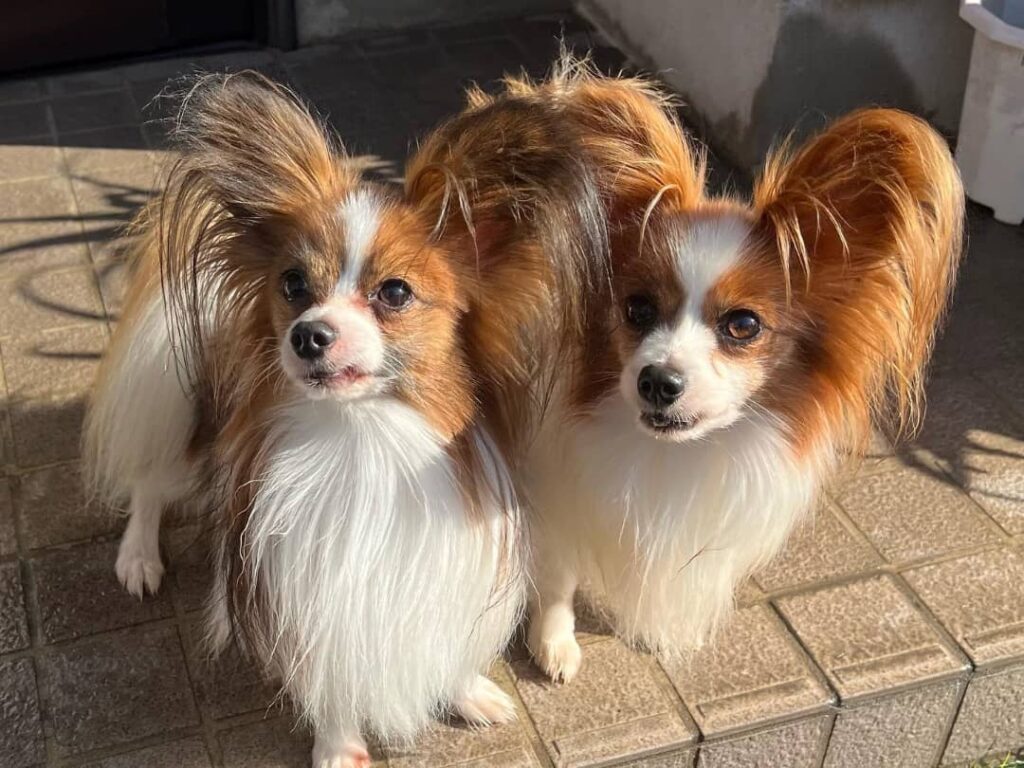ABOUT PAPILLON
About The Breed
The papillon is a petite yet hardy toy dog with an alert, active, and friendly demeanor. They are one of the smartest dog breeds and make great companions and family pets. The breed originated in France which is where they got their name—papillon means butterfly in French. Though named for the butterfly-like appearance of their erect ears, these dogs can also be seen in a drop-eared variety.
Learn more about the history, care needs, and characteristics of the papillon.
papillon chihuahua mix for sale, chihuahua papillon mix puppies
Origins
Paintings from the early 16th century depict tiny toy spaniels with drop ears that bear some resemblance to the hunting spaniels of the era. This breed, called the Phalène, would make appearances throughout France, Spain and the Low Countries.
Phalène dogs with erect ears slowly started appearing in the 17th and 18th century, and breeders started developing this variant.
Eventually breeders succeeded in creating stable lines of Phalène dogs with erect ears. The breed was called the Papillon due to its resemblance to a butterfly.
The Papillon’s popularity continues to rise as it has repeatedly shown its suitability for obedience and agility competitions.
papillon chihuahua mix for sale, chihuahua papillon mix puppies

Pros of Papillons
Friendly Highly trainable Active and playful
Breed overview
- Breed group — Toy group (American Kennel Club)
- Height — 8-11 inches
- Weight — 5-10 pounds
- Coat length & texture — Long, silky, flowy
- Coat color — Parti-colors, where the coat is over 50% with a combination of colors like black, brown, red, or fawn.
- Exercise needs — Average
- Intelligence — High
- Barking — Not excessive
- Life span — 14-16 years
- Temperament — Happy, social, and playful
- Hypoallergenic — No
- Origin — South Africa
Key Characteristics Of Papillons
Are Papillons Family-Friendly?
Yes, Papillons can be wonderful family pets who bond very well with their owners and family members. Due to their small size, it’s recommended that they only join families with older children.
Common Health Issues & Considerations
Papillons may suffer from:
Patellar luxation
A condition where the kneecap dislocates or moves out of its normal location within the knee joint.
Hypoglycemia
Collapsed trachea
A condition where the tracheal rings weaken and flatten, leading to respiratory distress and a chronic cough.
Nature / Temperament
Loving, Playful, Lively, Alert, and Intelligent
Suitable Environment
Papillons are adaptable to almost any living situation. They tend to be active even indoors, and they thrive on stimulation.
While they are well-suited to apartment living, they can live in any size of home. Papillons love exercising outdoors and will run free if given the opportunity.
Other Considerations
● Papillons are sensitive to anaesthesia and any veterinarian treating them should know this information.
● Some Papillons can have a high self-esteem despite their size, and will not back down when challenged.
● Papillon puppies for sale may cost a significant amount since a Papillon will only give birth to one to three puppies.
How can I take good care of my Papillon?
Nutrition
Papillon puppies should always be fed high-quality dog food. Even though they are small dogs, they still need enough protein to grow strong muscles. Clean water should be made available at all times.
Like most small breed puppies, Papillons will need multiple small meals throughout the day. You may consult with your vet about your dog’s diet and nutrition, if necessary.
Grooming
Papillons are generally not very difficult to groom, and most Papillon puppies and adults will need brushing around two to three times a week.
Recommended Grooming Tips
The Papillon’s distinctive ear hairs will require some extra care and attention since they are relatively delicate and may break if brushed too harshly.
Papillons intended for breed competition will need much more time at a professional groomer.
Brush your Papillon’s teeth regularly to prevent tooth and gum diseases, using only a vet-approved toothpaste.
Exercise
Papillons are both athletic and energetic, and need the stimulation that exercise provides. Around 30 to 40 minutes of exercise a day is sufficient for most Papillons. Papillon puppies may exercise outdoors as well, so long as they are cleared to do so by their veterinarian.
Take care not to over-exercise your Papillon puppy before their body is fully developed.
Training
Papillon puppies require a good amount of training so that they do not form bad habits and become poorly-behaved. They are intelligent dogs and can be trained very easily.
Obedience training is a priority for all Papillon puppies. Most Papillon puppies can start their basic training shortly after being taken home from the breeder.
If you are intending to compete with your Papillon puppy, you may choose to enrol them in training classes. If you do, ensure that the training methods are based on positive reinforcement.
Looking to register as a Papillon dog breeder? Download the RPBA guide on responsible breeding.
This is general information and should not be relied on for adopting or purchasing advice.

Papillon is a Top Notch Nog
The Papillon shares top billing with the Toy Poodle as the brightest and most trainable of the toy breeds. Indeed, the spirited, athletic Papillon is commonly chosen by obedience or agility trainers who want a top-notch competition dog in a very small package.
Papillon fun facts
Coming up with a pet name can be fun but tricky. Search no further! According to PetScreening’s 2024 database, the majority of our users name their male Papillons Gizmo; Charlie is the 2nd most popular male name. Meanwhile, most of our users with female Papillons love Bella, then Lola.
- “Papillon” is the French word for “butterfly”, which the breed’s fluttery ears resemble.
- Papillons were popular among French royalty, including Marie Antoinette.
- Papillons are considered one of the oldest toy breeds still in existence today.
papillon chihuahua mix for sale, chihuahua papillon mix puppies
